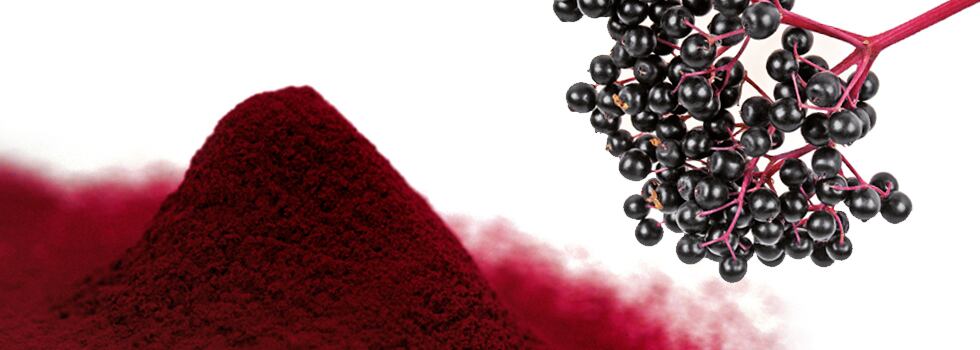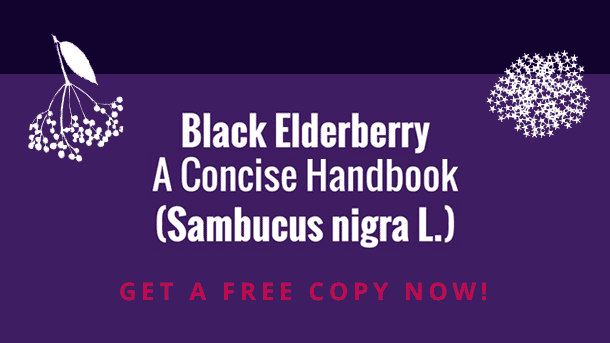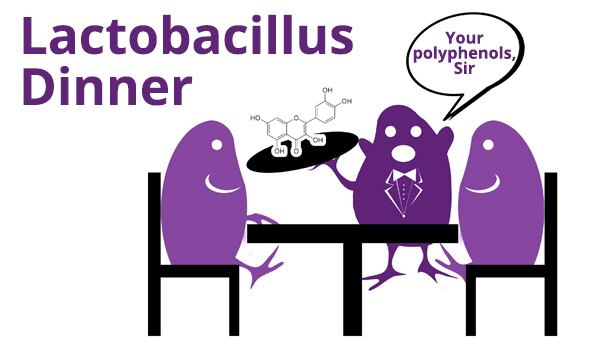European black elderberry has a long history of use in the management of common cold and flu-like symptoms. In recent years, this tradition has been validated by clinical data on the effects of elderberry extract, plus earlier-stage research into the mechanisms behind its effects. Now, Iprona is building on this legacy of research by conducting studies to show the key role polysaccharides play in the effects of elderberries.
The use of dried and fresh black elderberries in the treatment of the common cold and influenza goes back centuries and continues into the modern day, in part due to the validation of the folk medicine using modern scientific methods.
Clinical trials designed to assess the effects of elderberries and their extracts on people with colds and flu have achieved notable successes. One pilot study linked an elderberry extract to a significant decrease in flu-like symptoms in the 24 hours after the onset of treatment.1 Another trial found giving oral elderberry syrup to people infected with influenza resulted in their symptoms clearing up four days earlier and reduced their use of rescue medication.2
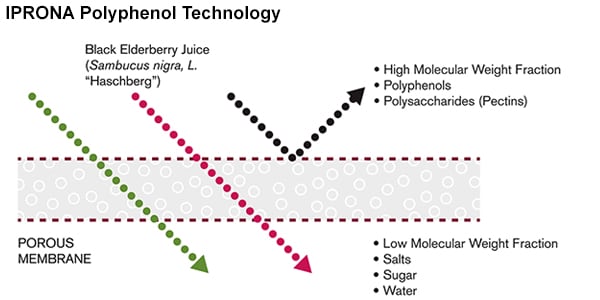
Given in combination with echinacea, elderberry has even performed as well as leading influenza antiviral oseltamivir in a study of 473 people with early flu symptoms.3 The subjects who received the echinacea-elderberry combination recovered as quickly as those who took oseltamivir.
Building on this body of evidence, researchers ran a randomized, double-blind placebo-controlled clinical trial to assess the effects of an elderberry extract on the physical and mental health of 312 economy class passengers.4 The trial tested the idea that molecules in elderberries can help people to withstand the stresses international air travel puts on respiratory health and general wellbeing.
Subjects in the elderberry cohort experienced 57 cold episode days, compared to 117 days among their peers in placebo arm. The elderberry group also reported a lower average symptom score than the placebo cohort. Both differences were statistically significant.
Explaining the effects of elderberries
Efforts to validate the effects of elderberries in humans have advanced in parallel to assessments of why the fruits drive positive changes in people with cold and flu symptoms. Notably, in vitro studies have shown elderberries have antibacterial and antiviral properties, spurring further research into the specific molecules and mechanisms behind these effects on microorganisms.5,6
Anthocyanins have emerged as a focal point of efforts to understand the effects of elderberries because the pigments haver known antioxidant, antimicrobial and antiviral properties.7,8 In European black elderberries, anthocyanins make up as much as 1% of the dry weight of the fruit, making the plant among the richest sources of the pigments.9,10 Levels of anthocyanins correlate to the antioxidant power of elderberries, too, confirming the significance of the molecules.11
However, other studies suggest the polysaccharides found in elderberries also play a critical role. In one experiment, researchers separated concentrated elderberry juice out into different fractions, analyzed their composition and assessed their effects on mice infected with the influenza virus.12
The high-molecular-weight fractions exhibited the most potent viral suppression. These fractions contained a smaller percentage of anthocyanins than lower-molecular-weight fractions, suggesting that molecules other than the antioxidant pigments were acting on the viruses.
As the high-molecular-weight fractions were rich in polysaccharides, these carbohydrates emerged as a potential driver of the antiviral effects. Subsequent studies of the immunomodulating properties of pectins, a group of cell wall polysaccharides, added weight to that hypothesis.13 The paper found that polysaccharides may drive the reported effects of elderberries on cold and influenza through the modulation of the immune system, specifically the macrophages that detect and destroy pathogens.
Iprona, a supplier of nutritional standardized extracts, is working with researchers at the University of Łódź in Poland to better understand the effects of elderberries, generating more evidence of the role polysaccharides play.
The researchers have shown that the extracts obtained using Iprona’s unique extraction method are particularly effective at activating monocytes, a type of innate immune cell. As importantly, the activated monocytes take their anti-inflammatory form and produce cytokines such as interleukin 10. This equips the monocytes to calm the inflammation that underpins many symptoms of common cold and flu, potentially explaining the effects of elderberries on people with these conditions.
Iprona and its collaborators are working to further elucidate the relationship between elderberries and monocytes, for example through studies to show the extract promotes the anti-inflammatory phenotype of the immune cells.
The researchers have identified the polysaccharide fraction of the extract as the driving force behind the effect on monocytes. Iprona’s unique extraction method, IPT (Iprona Polyphenol Technology), uses ultrafiltration to capture a different set of isolates without solvents than is achieved using classic ethanol extraction. Notably, IPT isolates anthocyanins, polyphenols, polysaccharides and the high-molecular-weight fraction linked to viral suppression.
Unlocking the potential of elderberries
Evidence for the role anthocyanins and polysaccharides play in immune support suggests Iprona and its unique solvent-free extraction method are well placed to help realize the potential of elderberries in the management of cold and flu symptoms. Through the use of ultrafiltration, rather than chemicals and solvents, Iprona creates extracts that capture the components of elderberries linked to health benefits without damaging the fruit matrix or affecting its taste, flavor and aroma profile.
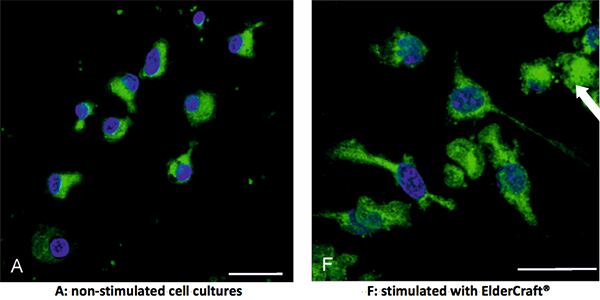
Iprona uses the process to produce ElderCraft, a water-soluble elderberry extract used in the clinical trial of economy class passengers and many other assessments of the effects of the fruit. ElderCraft is standardized to a polyphenol and anthocyanin specification, enabling producers of softgels, liquid supplements and other nutraceuticals to create products with effective daily doses of the molecules.
Through its extraction method and investment in research, Iprona is expanding our knowledge of the effects of elderberries and increasing the commercial opportunities for products based on the fruit. People have long used elderberries to manage cold and flu symptoms. Iprona and its collaborators are showing why, setting the stage for products that maximize the potential of the fruit.
References
1. Kong, F. Pilot clinical study on a proprietary elderberry extract: Efficacy in addressing influenza symptoms. Online J Pharmacol Pharmacokinet 5, 32–43 (2009).
2. Zakay-Rones, Z., Thom, E., Wollan, T. & Wadstein, J. Randomized study of the efficacy and safety of oral elderberry extract in the treatment of influenza A and B virus infections. J. Int. Med. Res. 32, 132–140 (2004).
3. Rauš, K., Pleschka, S., Klein, P., Schoop, R. & Fisher, P. Effect of an Echinacea-Based Hot Drink Versus Oseltamivir in Influenza Treatment: A Randomized, Double-Blind, Double-Dummy, Multicenter, Noninferiority Clinical Trial. Curr. Ther. Res. Clin. Exp. 77, 66–72 (2015).
4. Tiralongo, E., Wee, S. S. & Lea, R. A. Elderberry Supplementation Reduces Cold Duration and Symptoms in Air-Travellers: A Randomized, Double-Blind Placebo-Controlled Clinical Trial. Nutrients 8, 182 (2016).
5. Krawitz, C. et al. Inhibitory activity of a standardized elderberry liquid extract against clinically-relevant human respiratory bacterial pathogens and influenza A and B viruses. BMC Complement. Altern. Med. 11, 16 (2011).
6. Roschek, B., Jr, Fink, R. C., McMichael, M. D., Li, D. & Alberte, R. S. Elderberry flavonoids bind to and prevent H1N1 infection in vitro. Phytochemistry 70, 1255–1261 (2009).
7. de Pascual-Teresa, S. & Sanchez-Ballesta, M. T. Anthocyanins: from plant to health. Phytochem. Rev. 7, 281–299 (2008).
8. National symposium Creating markets for economic development of new crops in new uses. Issues in new crops and new uses: Proceedings of the 6th national symposium Creating markets for economic development of new crops and new uses, held in San Diego, California, October 14 to 18, 2006. (2007).
9. Thole, J. M. et al. A comparative evaluation of the anticancer properties of European and American elderberry fruits. J. Med. Food 9, 498–504 (2006).
10. Mikulic-Petkovsek, M. et al. Investigation of anthocyanin profile of four elderberry species and interspecific hybrids. J. Agric. Food Chem. 62, 5573–5580 (2014).
11. Ozgen, M., Scheerens, J. C., Reese, R. N. & Miller, R. A. Total phenolic, anthocyanin contents and antioxidant capacity of selected elderberry (Sambucus canadensis L.) accessions. Pharmacogn. Mag. 6, 198–203 (2010).
12. Kinoshita, E., Hayashi, K., Katayama, H., Hayashi, T. & Obata, A. Anti-influenza virus effects of elderberry juice and its fractions. Biosci. Biotechnol. Biochem. 76, 1633–1638 (2012).
13. Ho, G. T. T. et al. Structure-activity relationship of immunomodulating pectins from elderberries. Carbohydr. Polym. 125, 314–322 (2015).

